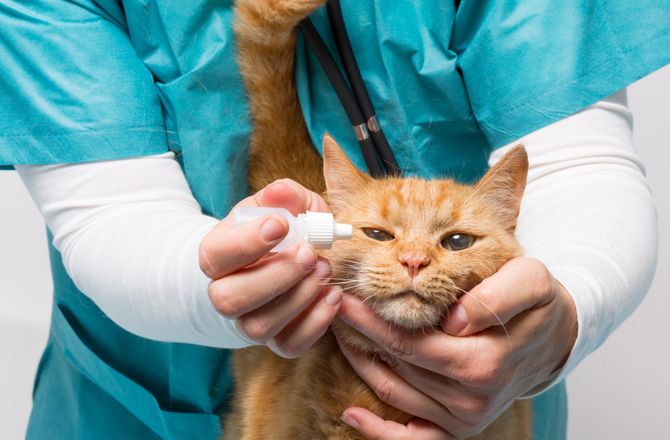How Can You Prevent Kitten Eye Infection? A Brief Guide for Vets

Ophthalmia neonatorum is the other name for the kitten eye infection. A newborn cat may have an eye infection affecting the cornea, which forms an outer layer of the cat’s eyes, or conjunctiva, which forms a layer covering the eye.
Kittens with red ears and cloudy, yellow, or greenish pus may have an eye infection.
The upper and lower eyelids may spread out to the sides and get stuck in that position. The cat may also experience an eye infection in one or both eyes.
Here, we will discuss kitten eye infections, the various types, their signs, and reasons, as well as how to stop these eye infections from happening.
Symptoms of Kitten Eye Infection
The symptoms of kitten eye infection must be identified early to seek medical treatment.
The following are signs by which a kitten may indicate an infection in the eyes:
- Swollen eyelids
- Excessive tearing
- Visible sores or ulcers
- Red and inflamed eyes
- Yellow or green discharge
- Cloudy or hazy appearance
- Squinting or difficulty opening eyes
- Frequent pawing or rubbing at the eyes
Types of Kitten Eye Infections
Kittens are often prone to eye infections for several reasons, and they are grouped into different kinds of bacterial, viral, and fungal pathogens.
Such may vary in classification.
Here are some of the standard types:
- Bacterial Conjunctivitis
- Caused by:
- Chlamydia bacteria
- Staphylococcus bacteria
- Symptoms:
- Redness
- Swollen eyes
- Green discharge
- Sticky yellow discharge
- Treatment:
- Antibiotic eye drops
- Ointment prescribed by a vet
- Viral Conjunctivitis
- Caused by:
- Feline herpesvirus (FHV-1)
- Symptoms:
- Respiratory issues
- Watery discharge
- Coughing
- Sneezing
- Clear
- Treatment:
- Antiviral medications
- And supportive care
- Caused by:
- Fungal Eye Infections
- Caused by:
- Fungal spores in the environment
- Caused by:
- Symptoms:
- Redness
- Swelling
- Thick discharge
It is often linked to poor hygiene.
- Treatment:
- Antifungal medications prescribed by a vet.
- Corneal Ulcers
- Caused by:
- Trauma
- Untreated infections
- Caused by:
- Symptoms:
- Cloudy eyes
- Excessive tearing
- And visible sores on the cornea
- Treatment:
- Immediate veterinary care with antibiotics
- Use Pain relief medications
- Entropion
- Caused by:
- Genetic defect where the eyelid rolls inward, irritating the eye.
- Symptoms:
- Rubbing at the eye
- Inflammation
- Redness
- Caused by:
- Treatment:
- Surgical correction to prevent further irritation.
Causes of Kitten Eye Infections
The primary causes of kitten eye infections can vary, but they often include:
- The most common causative agent is Herpesvirus (FHV-1), which spreads rapidly within multi-cat households.
- Newborn kittens will be very susceptible to such bacteria as Chlamydia and Staphylococcus.
- Close contact with infected cats can readily lead to the spread of eye infections.
- Kittens raised in unsanitary conditions may develop infections.
- Eye injuries from scratches or accidents can lead to infections.
- Dust, dirt, or foreign particles can irritate the kitten’s eyes.
- Kittens with compromised immune systems.
How to Prevent Kitten Eye Infections
Some of the things that veterinarians can advise pet owners to do concerning their kitten’s eyes include the following:
- Maintain Proper Hygiene
- Clean the kitten’s face and eyes using a damp cloth material severally.
- Make sure the beds of the kittens are clean. Bath them regularly to have minimal contact with bacteria or fungi.
- Ensure a Healthy Diet
- Offer a kitten the right proportion of nutrients in the diet; in this respect, a balanced diet develops a kitten’s immune system. Therefore, a kitten does not easily fall prey to most infections.
- Regular Veterinary Checkups
- The kitten should receive vet check-ups for early diagnosis. This will ensure proper treatment.
- Avoid Exposure to Sick Cats
- Limit contact between infected cats and kittens in multi-cat households to control the spread of infectious eye diseases.
- Protect Kittens from Trauma
- Kitten-proofing homes can also help avoid accidents or trauma leading to eye injuries.
- Keep needles and harmful surfaces out of the reach of kittens.
Treatment Options for Kitten Eye Infections
Prompt treatment is essential to prevent complications if a kitten develops an eye infection.
Veterinarians treat kitten eye infections in the following general steps:
Topical antibiotics:
- For bacterial infections, prescribe antibiotic eye drops or ointments.
Oral antibiotics:
- Oral antibiotics may be prescribed if the infection is severe enough to fight off.
Antiviral medications:
- Feline herpesvirus infections are treated with antiviral drugs and supportive care.
Eye cleaning:
- Owners must be trained on how to clean a kitten lightly so that the discharge from the eyes does not run, thus preventing the eyelids from sticking to each other.
Kitten Eye Infection Prevention Chart
| Prevention Method | Action |
| Hygiene | Regularly clean eyes and bedding to prevent bacterial buildup. |
| Diet | Provide a balanced diet to strengthen the immune system. |
| Veterinary Checkups | Schedule routine vet visits for early detection of issues. |
| Environment Cleanliness | Keep living areas dust-free and sanitized. |
| Isolation | Separate sick cats to prevent the spread of infection. |
| Eye Moisturizers | Use artificial tears to keep eyes lubricated. |
| Vaccinations | Vaccinate against common viruses that cause eye infections. |
To Conclude!
It’s veterinarians’ responsibility to guide pet owners on the signs that indicate kitten eye infections and the measures that can be taken to avoid them.
Ensuring proper hygiene, early and frequent examination and the correct type of feeding can minimize the risk of eye-related infections in kittens.
DVM Central is a go-to marketplace that connects veterinarians to various suppliers of veterinary products.
Here, you can explore and shop for the perfect veterinary products for your practice needs. Enjoy special discounts.